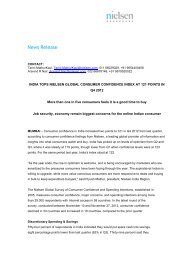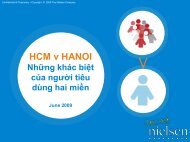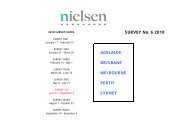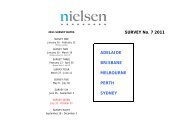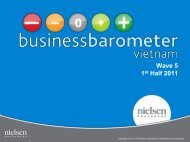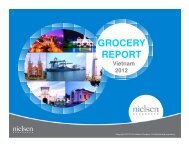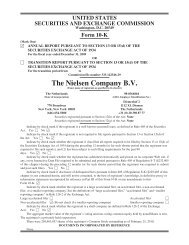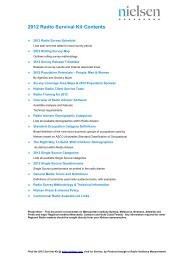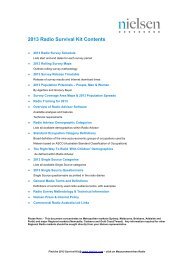2010 Radio Ratings Survival Kit - Nielsen
2010 Radio Ratings Survival Kit - Nielsen
2010 Radio Ratings Survival Kit - Nielsen
Create successful ePaper yourself
Turn your PDF publications into a flip-book with our unique Google optimized e-Paper software.
1. SAMPLE DESIGN<br />
The <strong>Nielsen</strong> Company - <strong>2010</strong> <strong>Radio</strong> <strong>Survival</strong> <strong>Kit</strong>.<br />
RADIO SURVEY METHODOLOGY AND OTHER TECHNICAL INFORMATION<br />
The sample on which all radio survey information is based, is a stratified multistage probability sample selected in the following manner:<br />
Page 1 of 5<br />
The total sample requirement of Census Collector's Districts (CDs) is allocated to the regions making up the survey area (see area definitions elsewhere in survival kit) in proportion to<br />
the 2008 Estimated Resident Population. Within each region, the sample of CDs is then allocated to the Statistical Local Areas (SLAs) which make up that region in proportion to the<br />
2008 Estimate of occupied private dwellings. SLAs, which are too small to attract sample, are grouped with SLAs adjacent on a geographically ordered list.<br />
Within each region SLAs (or groups of SLAs) are divided into bands according to the number of CDs required. The CDs are ordered in a geographic serpentine order, and grouped<br />
into bands of adjacent CDs such that the bands have equal numbers of occupied private dwellings according to the 2008 Estimated Resident Population. One CD is selected in each<br />
band in Sydney, Melbourne, Brisbane, Adelaide and Perth. If a selected CD has recently been used in a <strong>Nielsen</strong> Media survey, a further selection is obtained in the same manner. In<br />
some cases CDs are combined to build up the size of the area to a minimum level.<br />
Geographic serpentine ordering of areas is done by starting with the area in the north eastern corner (top right) and proceeding from east to west, and then west to east, gradually<br />
moving southwards, in a winding or serpentine fashion. This method ensures an even spread of the sample across the target area.<br />
Metropolitan Markets<br />
In Sydney, Melbourne, Brisbane, Adelaide and Perth during the first survey wave, a<br />
quarter of the selected CDs, spread throughout the entire survey area, are surveyed each<br />
week. In subsequent survey waves one fifth of the CDs are surveyed each week. Data<br />
from two survey waves are combined in producing a report although only the last two<br />
weeks of data carry over from the first survey into Wave #2 in the markets of Sydney,<br />
Melbourne, Brisbane, Adelaide and Perth.<br />
Selected CDs are mapped, blocks numbered and starting points selected at random. To<br />
achieve the planned sample, a minimum of four diaries is placed in each interviewing area<br />
each week.<br />
Regional Markets<br />
In the majority of regional markets the selected CDs are surveyed across the whole survey<br />
period. In certain larger markets the selected CDs are surveyed across half the survey<br />
period, then re-visited for the other half.<br />
Selected CDs are mapped, blocks numbered and starting points selected at random. To<br />
achieve the planned sample, a minimum number of diaries are placed in each interviewing<br />
area each week. The actual number is depends on the total sample and number of CDs<br />
to be surveyed.<br />
Interviewing follows a prescribed order of blocks within each CD. Sampling is sequential over time with up to three calls being made on every selected household. These calls are<br />
spaced over alternate waves of the survey. Interviewers rotate their calls over different times of the day to give full opportunity for all types of households to participate.<br />
For some regional markets, in some of the more outer lying areas, participants are<br />
recruited by telephone and diaries are mailed to respondents. The sample for these is<br />
designed as a random sample of population with telephones in the defined survey area.<br />
Initially, the survey area is defined in groups of SLAs/CDs as per above. These areas are<br />
then converted into telephone exchange areas as defined by Telstra. Telephone number<br />
ranges available to each exchange are then used to generate telephone numbers at<br />
random. The amount of random telephone numbers generated for each exchange are<br />
selected in proportion to the population within each exchange area.



